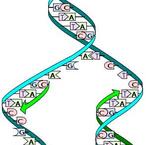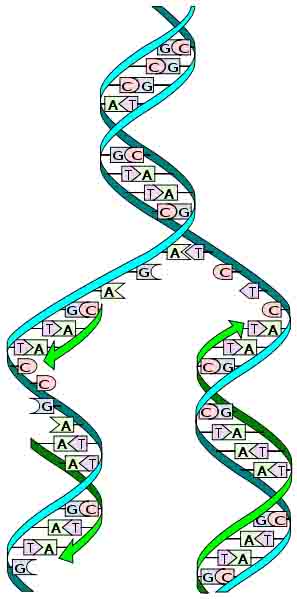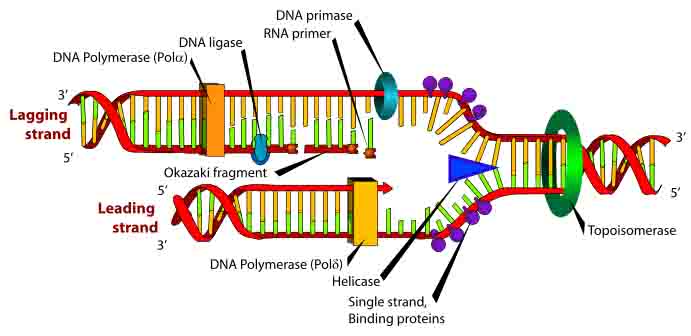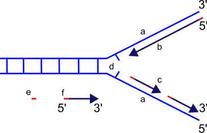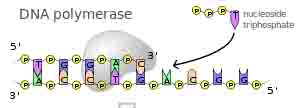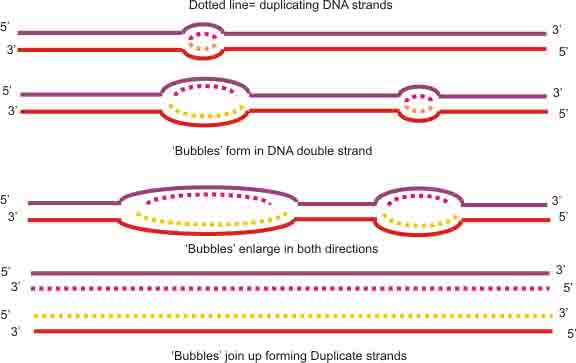 | ||||
Genetic Replication
Copying of DNA
CLASS NOTES from Science Prof Online
The process of copying the double-stranded DNA molecule is called replication.
Prokaryotes replicate their DNA (the nucleoid) throughout the interval between cell divisions.
In eukaryotes, the timing of replication in the nucleus is highly regulated.
Article Summary: A cell must copy its DNA before it divides, so that both daughter cells have a complete copy of the genetic information. This article explains replication.
Genetic Replication – Copying of DNA
 | ||||
You have free access to a large collection of materials used in a college-level introductory microbiology course. The Virtual Microbiology Classroom provides a wide range of free educational resources including PowerPoint Lectures, Study Guides, Review Questions and Practice Test Questions.
Semi-conservative Replication
Each double stranded DNA molecule holds the same genetic information. Therefore each strand can serve as a template for the construction of a new strand. The template (original) strands are separated and preserved, while the new strands are assembled from nucleotides. This is called semi-conservative replication, since the each of the two resulting DNA molecules consist of one conserved old strand and one brand new strand. These resulting double-stranded DNA molecules, blended from old and new, are identical to each other.
Replication Bubbles
Replication begins at an origin (or many origins) along a DNA molecule, where the DNA is “unzipped” when paired nitrogenous bases are separated from each other. The openings in the DNA are called replication “bubbles.” At either end of these bubbles is a replication fork, a ‘Y’-shaped region of the bubble where new the strands of DNA are built. The enzyme helicase untwists the DNA at the replication fork, and another enzyme, DNA polymerase, catalyzes the construction of new DNA strands.
Prokaryotic DNA is arranged in a circular shape, with only one replication origin. Eukaryotes, which are more complex and have more DNA, form several replication bubbles, allowing the process of replication to be completed more quickly. Despite these differences, the underlying process of replication is the same for both prokaryotic and eukaryotic DNA.
The nucleotide building blocks of DNA are triphosphates (nucleotides with three phosphates) and energy is stored in the bonds that link the phosphates together. When one of these phosphate bonds break, this provides the energy to add that nucleotide to the growing nucleic acid molecule.
To learn more about molecular genetics see the following animations and SPO Class Note Articles:
Animations
- DNA Structure Cell Biology Animation from John Kyrk.
- Build a DNA Molecule from University of Utah.
- DNA Replication animation and review questions.
- DNA Replication Process animated video by FreeScienceLectures.com.
- DNA Replication step-through animation by John Kyrk.
- Genetics: Tour of the Basics, Genetic Science Learning Center, University of Utah
Class Notes
- Deoxyribonucleic Acid Structure: What Is DNA?
- Ribonucleic Acid Structure & Function - What Is RNA and What Does It Do?
- What Are Nucleotides & Nucleic Acids? Structure and Function of DNA, RNA and ATP
- Nucleic Acid Function of DNA & RNA: Genetic Replication, Transcription & Translation
Sources
- Bauman, R. (2005) Microbiology. Pearson Benjamin Cummings.
- Park Talaro, K. (2008) Foundations in Microbiology, McGraw-Hill.
- Campbell, N. & Reece, J. (2002) Biology, 6th Edition, Benjamin Cummings.
This means that one new strand, the “leading strand”, will have new nucleotides continuously added onto the hydroxyl portion of the previous nucleotide. The other new strand, the “lagging strand,” which runs in the opposite direction, must be made in a piecemeal fashion, as small 3’ to 5’ bits and pieces, called Okazaki fragments, ultimately joined together by the enzyme DNA ligase.
In the double-stranded DNA molecule, one strand runs from the 5’ end to the 3’ end, while the other runs 3’ to 5’. DNA polymerase, the enzyme that builds DNA strands, can only add nucleotides at the free 3’ end of a growing strand, always forming the new DNA strands in the 5’ to 3’ direction only.
 | ||||||
You have free access to a large collection of materials used in a college-level introductory Cell Biology Course. The Virtual Cell Biology Classroom provides a wide range of free educational resources including Power Point Lectures, Study Guides, Review Questions and Practice Test Questions.
How Do Nucleotides Put Themselves Together Into New Nucleic Acid Strands?
The construction of a nucleic acid is an anabolic polymerization process. Anabolic reactions use energy to build bigger molecules. Polymerization is the process of taking monomers, such as nucleotides, and putting them together into polymers (large molecules composed of many monomers).
Leading and Lagging Strand
Each of DNA’s two sugar phosphate backbones run in opposite directions, so they are considered anti-parallel. The end of each strand is distinct, with the 5’ (five prime) end terminating in a phosphate, and the 3’ (three prime) end with a dangling hydroxyl group (OH-).
 | ||||
of Science Prof Online
You have access to a large collection of free science teaching materials used in high school and college-level introductory science courses. The SPO Instructors Corner has resources for teaching general science, anatomy & physiology, chemistry, cell biology genetics, immunology and microbiology.
Portions of this article originally appeared on Suite101 online magazine.
Page last updated: 5/2013
 | ||||||
SPO VIRTUAL CLASSROOMS
 | ||||||
SPO is a FREE science education website. Donations are key in helping us provide this resource with fewer ads.
Please help!
(This donation link uses PayPal on a secure connection.)
